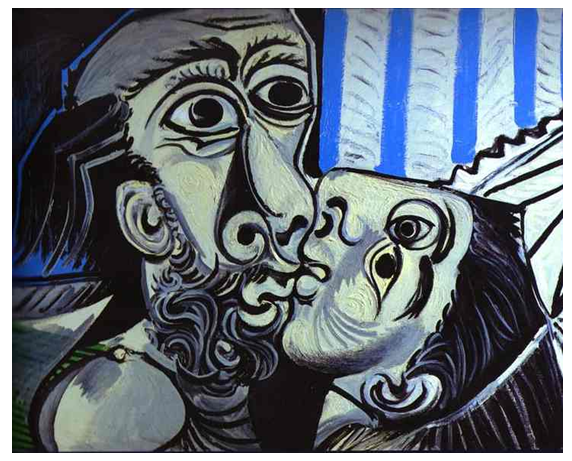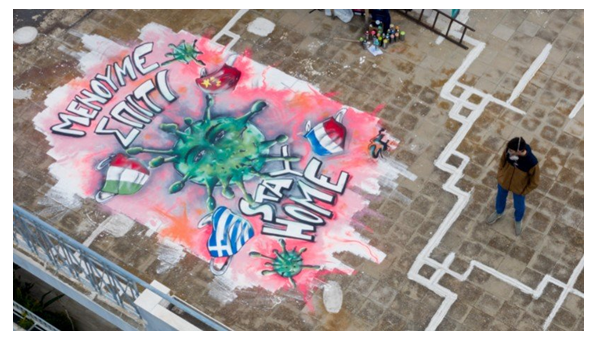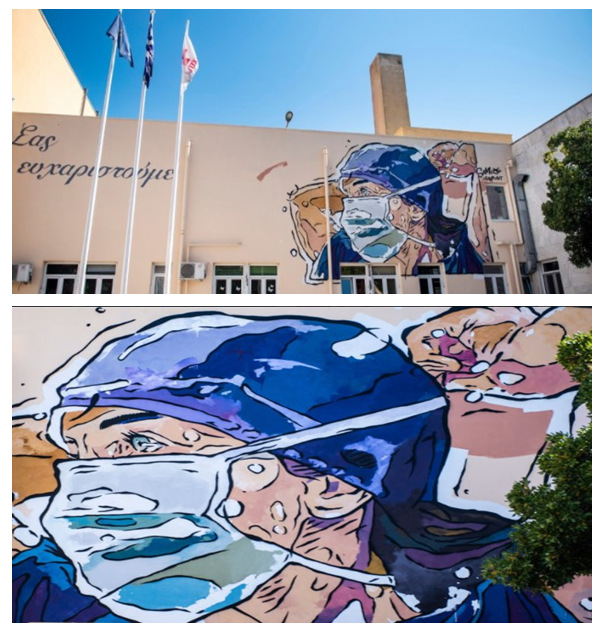-
Paper Information
- Paper Submission
-
Journal Information
- About This Journal
- Editorial Board
- Current Issue
- Archive
- Author Guidelines
- Contact Us
International Journal of Arts
p-ISSN: 2168-4995 e-ISSN: 2168-5002
2021; 11(1): 1-5
doi:10.5923/j.arts.20211101.01
Received: Feb. 20, 2021; Accepted: Mar. 10, 2021; Published: Mar. 15, 2021

Graffiti in Greece at the Time of Covid-19
Stella Mouzakiotou1, Dionysios Anastasopoulos2
1Art Historian, Hellenic Open University & University of West Attica, Athens, Greece
2Lecturer University of Nikosia, Cyprus & Visiting Professor Ionion University, Greece
Correspondence to: Stella Mouzakiotou, Art Historian, Hellenic Open University & University of West Attica, Athens, Greece.
| Email: |  |
Copyright © 2021 The Author(s). Published by Scientific & Academic Publishing.
This work is licensed under the Creative Commons Attribution International License (CC BY).
http://creativecommons.org/licenses/by/4.0/

The first (and maybe the only) topic of discussion during the last month worldwide is the coronavirus pandemic. Most of the world's cities have been put under a state of emergency, thousands of people have been sick and the economy of many countries is on the verge of collapse. This data is more than enough to inspire a street artist to express himself through the art of graffiti.Street artists have the great skill to depict in a unique way aspect of everyday routine, life, political situation in a way that we often cannot express in words. As citizens, mainly of cities, they depict on these walls their own experience (which is also ours) using colors, messages, humor, sarcasm, irony. So how could they not wander in the streets in the midst of a pandemic, like this with the global spread of corona virus, which is changing our daily lives to a point that affects the heart itself of our culture.The aim of the research study is to highlight the relationship between street art and the health and social developments that happening around us. It also highlights a tacit interaction in the art of street artists in different countries of Europe and the rest of the world. The symbolism of graffiti created in this health, economic and political crisis is the fundamental research field of this article. The inventiveness, the causticity, the re-interpretive approach of the important works of art of the past, the ridicule, the acidity and the explosiveness are some of the visualized messages perceived by the viewer.
Keywords: Graffiti Art, Covid-19, Communication, Writers, Street art, Corona virus, Health developments, Visualized messages
Cite this paper: Stella Mouzakiotou, Dionysios Anastasopoulos, Graffiti in Greece at the Time of Covid-19, International Journal of Arts, Vol. 11 No. 1, 2021, pp. 1-5. doi: 10.5923/j.arts.20211101.01.
Article Outline
1. Introduction
- «We have to be very careful with freedom. Both in painting and elsewhere. Sometimes we're freer than ever, at a time when we feel more captive than ever! If there is any freedom in what we do, then there is nothing but to free something from within, to resist, even if you have to be on your own, do not stop loving. That's freedom. The text is an excerpt from Pablo Picasso's book "Thoughts on Art"...Kissing was one of the prevailing erotic motifs - including the embrace of the couple pictured - that dominated Pablo Picasso's agenda during the last years of his life. In "Kiss" (1969), the creator portrays a bearded man passionately kissing a young woman (fig. 1). The unbroken lines that make up many elements of the composition - the woman's ear and the man's hairline, for example - indexes the experienced artist's playful cubist proposal, while the ecstatic, huge eyes seem to complement the sensuality of this passionate contact. Picasso chose to paint a kiss that is not a romantic touch of the lips, but a game using the tongue. It is clear that this is not a simple kiss, but an ecstatic allegory for all kinds of mating that someone can remember or imagine. [1]
 | Figure 1. Pablo Picasso. Kiss, 1969. (Source: https://www.pablopicasso.org/the-kiss.jsp) |
2. The Art of "Exclusion" and Embrace
- Poel is the nickname of one of Norway’s most important artists, coming from the latin word"Populus", meaning "people". His artistic proposal includes paintings, photographs, sculptures, installations, street art, etc. His work has been presented and analyzed in conferences and many media in recent years. It was first nationally recognized and awarded Norway in the mid-2000s for decorating abandoned buildings in the Lofoten Islands of northern Norway, bringing a phenomenon of urban street art to rural areas, thus sparking a debate about the concept and targeting of "street art". His public artworks are found all over the world, including Scandinavia, UK, Iceland, USA, India, Thailand, China, Japan, Russia, Peru and more.The mural "Lovers" which was painted by the street artist Pobel on March 20, 2020 in the Norwegian city of Bryne, has been characterized as an iconic creation. (fig. 2). A young couple kisses or rather tries to kiss each other because they both wear a protective mask. This is a resounding differentiation from picasso's kiss, which we mentioned before, since here, in the love touch, a mask is between their mouths!!!!! "In these difficult times, I hope this work will be a positive contribution and spread a little joy. Be safe and take care of each other," is what he posted on his Instagram account.
 | Figure 2. Pobel. Εραστές, 2020, Norway. (Source: https://streetartnews.net/2020/05/pobel-the-lovers-print-release-may-10th.html) |
 | Figure 3. TV Boy. Clean air now, 2020, Rome. (Source: https://www.rferl.org/a/mural-masks-coronavirus-inspires-global-graffiti/30527353.html) |
 | Figure 4. Banksy. "Girl with pearl earring", 2020, United Kingdom: Bristol. (Source: https://4m.cn/NWSRR) |
3. Covid and Graffiti Art in Greece [5]
- The Greek street artist Lefteris Toulis, an artist from Drama with studies in the Department of Fine Arts of Thessaloniki, influenced by everyone’s daily battle to halt the corona virus pandemic, created an impressive graffiti on a wall of an apartment building, on Hephaestion Street of Drama and the result is riveting. It is an ancient Greek statue depicted wearing a mask and holding a pole as a weapon. Its creation captures the harsh and unprecedented reality that the world is experiencing today in just a few square meters of surface area. [6]With the backdrop of the poles of Olympian Zeus and the traditional houses, a modern ancient Greek wearing a mask "fights" in the neighborhood (Fig. 5). He fights for his life, to stand on his feet having his pole, which is his weapon, as a crutch. The past andf the present of Greece of today meet in 2020, in the face of corona virus, poverty and uncertainty. "I show the personal struggle of each of us every day. A new God, a fantastic friend, is looking forward to a brighter future," Mr. Toulis pointed out on Greek public television (ERT), describing his work. It is an interesting artistic proposal that is a field of conflict between the Republic-Freedom of ancient Athens and the internment and mutilation of freedom today.
 | Figure 6. S.F. Face with mask, graffiti, Greece. (Source: https://www.iefimerida.gr/zoi/koronoios-graffiti-16hronoy-se-taratsa-tis-athinas) |
 | Figure 7. S.F. Stay home, graffiti, Greece. (Source:https://www.newsbreak.gr/ellada/88118/nearos-stelnei-minyma-aisiodoxias-kata-toy-koronoioy-me-gkrafiti/) |
 | Figure 8. Same84. "Thank you", 2020, graffiti, Greece. (Source: https://www.iefimerida.gr/ellada/ahepa-eyharisto-se-giatroys-nosileytes-me-gkrafiti) |
4. Conclusions
- Street art artists come to give in their unique way, color, beauty and hope in yet another public space, such as that of hospitals. [9]They try to either promote the basic messages of the time, such as "stay home", or "go home", and "wash our hands" or pay tribute to the heroes of the front line for the battle against covid-19. There are also not a few of them who approach the subject with humor by placing a medical mask on important works of art (e.g. the girl with the pearl earring) or commenting on the required social distance, love in the years of covid-19, and of course the necessary accessories of the time, such as mask and antiseptic liquid. Finally, even the most artistic performances with emphasis on the depiction of the virus and references to the damage it causes to the lungs of man are not lacking. [10]
 Abstract
Abstract Reference
Reference Full-Text PDF
Full-Text PDF Full-text HTML
Full-text HTML